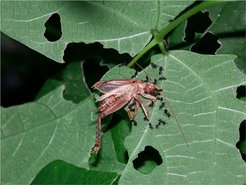Red light regulates nectar secretion
Nectar production in Lima beans depends on light quality
Flowering plants produce nectar to attract insect pollinators. Some plant species, such as the Lima bean, not only secrete nectar from their flowers but also from so-called extrafloral nectaries to attract ants which in turn fend off herbivores. Scientists at the Max Planck Institute for Chemical Ecology in Jena, Germany, have discovered that the production of extrafloral nectar is light dependent. Using a special photoreceptor, the phytochrome, scientists have shown that the plants are able not only to distinguish between day and night, but also to adapt their nectar secretion to current light conditions. The phytochrome probably influences the regulation of a special enzyme that binds the plant hormone jasmonic acid to the amino acid isoleucine. The emerging molecule affects the secretion of extrafloral nectar in such a way that the plant’s defence against herbivores is most effective whenever herbivory is most likely - or, more precisely, during the day. (PNAS Early Edition, September 20, 2010)

Plants need to defend themselves continuously against herbivores to survive and reproduce. They do this directly by producing toxic substances, such as nicotine, or indirectly, by calling their enemies’ enemies for help. An example of an indirect defence is the release of volatile substances that attract predatory insects or parasitoids and guide them to their prey; for example, predatory wasps or bugs are led to a caterpillar that is feeding on the plant.
Another indirect defence is the secretion of extrafloral nectar from special leaf organs. In this way Lima beans attract ants that not only enjoy the sweet nectar but also defend the plant against herbivores. Scientists in the Department of Bioorganic Chemistry study this "sweet" defence mechanism. Radhika Venkatesan, a PhD student from India, completed a series of experiments on this topic and tested whether nectar secretion in Lima beans is light dependent. "After all, nectar consists mainly of sugars, and sugars are primary products in the process of photosynthesis - which depends on light," notes the scientist. Plants contain phytochrome proteins as photoreceptors in their leaves, which is the reason why phytochromes are sometimes called "the eye of the plant."
"Not the light intensity, but light quality or composition plays a decisive role in regulating nectar production in Lima bean," says Wilhelm Boland, director of the Max Planck Institute. As he explains, the phytochrome in the plant absorbs red light that enables the plant to distinguish the diurnal and seasonal variation of sunlight quality. Radhika Venkatesan’s experiments are the first to demonstrate that plants also use the phytochrome system to set up their lines of defence effectively and economically.
The hormone jasmonic acid is known to be an important signal that plants produce after being wounded by herbivores. It also plays a central role in regulating nectar secretion. The scientists have discovered that phytochrome-mediated light regulation has a significant impact on the signalling effect of jasmonic acid: Free jasmonic acid inhibits nectar secretion in the dark but stimulates its production in the light. Radhika Venkatesan found the key to this light-regulated behaviour in a reaction that binds jasmonic acid (JA) to the amino acid isoleucine (Ile). The emerging conjugate JA-Ile is a signal molecule already known from other studies. For the first time, it has been identified as the actual elicitor of nectar secretion. Additional experiments have confirmed that nectar production does not increase, if binding of JA and isoleucine is prohibited by an added inhibitor. If plants are wounded in the dark to stimulate JA production, JA-Ile is produced only in those leaves that were previously exposed to red light.
